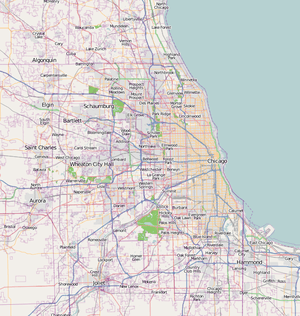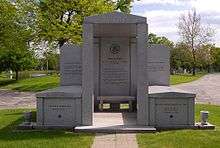Oak Woods Cemetery
|
Chapel and grounds at Oak Woods Cemetery | |
   | |
| Details | |
|---|---|
| Established | February 12, 1853 |
| Location | Chicago, Illinois |
| Country | United States |
| Coordinates | 41°46′N 87°36′W / 41.77°N 87.6°W[1]Coordinates: 41°46′N 87°36′W / 41.77°N 87.6°W[2] |
| Website | Oak Woods Cemetery |
Oak Woods Cemetery is a large Victorian era cemetery in Chicago, Illinois. Located at 1035 E. 67th Street, in the Greater Grand Crossing area of Chicago's South Side. Established 165 years ago on February 12, 1853, it covers 183 acres (74 ha).[3]
It is the setting for a mass grave and memorial for Confederate prisoners of war. Oak Woods is also the final resting place of several famous Americans including Harold Washington, Ida B. Wells, Jesse Owens, and Enrico Fermi.
History
The first burials took place in 1860. After the Civil War (1861–1865), several thousand Confederate soldiers, prisoners who died at Camp Douglas, were reburied here. According to a plaque on the site, soldiers were buried in “concentric trenches.” A monument and marker, which former Kentucky Lieutenant Governor John C. Underwood helped construct, probably inflates the number of soldiers buried as 6,000, but lists the names of more than 4,000.[4][5] Another, smaller memorial commemorates the Union soldiers who died at Camp Douglas, often from contagious diseases. The bodies from Camp Douglas had originally been buried at Camp Douglas and the City Cemetery, which was closed and removed during expansion of Lincoln Park and urban renewal following the Great Chicago Fire of 1871.[6] They were exhumed and reinterred together in a mass grave, which came to be known as Confederate Mound, reputedly the largest mass grave in the Western Hemisphere.[7]
In response to the establishment of the Confederate memorial, in 1896, Thomas D. Lowther, a pre-war resident of the South, erected near it an abolitionist monument.[8] The abolition monument is a large black marble cenotaph to pre-war southerners, "unknown heroric men", "martyrs" who had opposed slavery and disunion. Near the beginning of the war, Lowther had been forced to flee his home in Florida because of his anti-slavery and pro-Union stance.[9]
The cemetery now contains the graves of many prominent African Americans, including Chicago's first African-American mayor, Harold Washington. Journalist and anti-lynching activist Ida B. Wells, Olympic sports hero Jesse Owens, and gospel music pioneer Thomas A. Dorsey are buried in the cemetery.[10]
Famous nuclear physicist Enrico Fermi has his final resting place here. The cemetery also has a section for U.S. veterans of several wars, and a separately-maintained Jewish section.

Notable burials
- Cap Anson (1852–1922), Major League Baseball Hall of Fame
- Faith Bacon (1910–1956), Burlesque dancer and actress
- Frank Bacon (1864–1922), actor and playwright
- Adolphus C. Bartlett (1844-1922), businessman, philanthropist
- Gary Becker (1930-2014), economist, Nobel prize winner
- Arthur M. Brazier (1921-2010), activist, pastor
- Woodnut S. Burr (1861-1952), ardent worker for Women's suffrage in the United States
- Frank Butler (1872–1899), Pitcher and outfielder in pre-Negro Leagues baseball
- Otis Clay (1942–2016), Blues and soul singer
- James "Big Jim" Colosimo (1878–1920), boss of the Chicago Outfit
- William Craig (1855–1902), first Secret Service agent to die on duty
- Charles S. Deneen (1863–1940), politician
- Thomas A. Dorsey (1899–1993), composer, the "father of Gospel music"
- Walter Eckersall (1886–1930), All-American quarterback and sportswriter
- Mircea Eliade (1907–1986), Romanian historian of religion, fiction writer, philosopher, and professor at the University of Chicago
- Enrico Fermi (1901–1954), physicist, creator of the first nuclear reactor
- Nancy Green (1834-1923), storyteller, cook, activist, and the first woman to portray Aunt Jemima
- Jake Guzik (1886–1956), gangster and bookkeeper for Al Capone; aka "Greasy Thumb"
- John Marshall Hamilton (1847–1905), 18th Governor of Illinois
- William Draper Harkins (1873–1951), nuclear chemist
- Monroe Heath (1827–1894), mayor of Chicago
- John Christen Johansen (1876–1964), portraitist and landscape painter
- Charles Johnson (1909–2006), pitcher and outfielder for the Chicago American Giants of the Negro League
- Eunice W. Johnson (1916–2010), business magnate and spouse of John H. Johnson
- John H. Johnson (1918–2005), founder and publisher of Ebony and Jet magazines, spouse of Eunice W. Johnson
- Kenesaw Mountain Landis (1866–1944), Hall of Fame, First Commissioner of Baseball
- Richard Loeb (1905–1936), crime figure – cremated here, ashes returned to family
- Little Brother Montgomery (1906–1985), blues piano player and singer
- Jesse Owens (1913–1980), Olympic track and field champion
- Eugene Sawyer (1934–2008), second African-American Mayor of Chicago (1987–1989)
- J. Young Scammon (1812–1890), attorney, banker, newspaper publisher
- Maud Slye (1879–1954), University of Chicago pathologist
- Roebuck "Pops" Staples (1915–2000), Gospel singer
- Willie Stokes (1937–1986), Chicago mobster
- William Hale Thompson (1869-1944), Mayor of Chicago
- June Travis (1914–2008), film actress
- Herbert J. Tweedie (1864–1906), golf course architect
- Bill Veeck (1914–1986), Major League Baseball owner – cremated here, ashes returned to family
- Albertina Walker (1929–2010), singer, songwriter, "Queen of Gospel"
- Harold Washington (1922–1987), lawyer, politician, first African American Mayor of Chicago
- Ida B. Wells (1862–1931), social reformer, civil rights activist
- Junior Wells (1934–1998), Blues musician
- Ben Wilson (1967–1984), Chicago Simeon H.S., 1984–85 #1 Ranked high school basketball player in America
- James Hutchinson Woodworth (1804–1869), Mayor of Chicago
- Otto Young (1844–1907), "Merchant Millionaire" of Chicago and Lake Geneva, Wisconsin
Roland Burris tomb

Roland Burris, the U.S. Senator appointed by Illinois governor Rod Blagojevich, constructed a family tomb at 41°46′16″N 87°36′08″W / 41.77122°N 87.60215°W in the Oak Woods Cemetery, in preparation for his and his wife's eventual interment. The tomb recites Burris accomplishments and received considerable publicity (often negative) after Burris' appointment.[11][12][13] [14]
See also
References
- ↑ "Oak Woods Cemetery". Geographic Names Information System. United States Geological Survey.
- ↑ "Oak Woods Cemetery". Geographic Names Information System. United States Geological Survey.
- ↑ "History". Oak Woods Cemetery. Retrieved 28 December 2014.
- ↑ Minutes of the 9th Annual Meeting of the Confederate Veterans. New Orleans: Hopkins Printing Office. 1900. pp. 109, 172–175.
- ↑ Wagner, Margaret E.; Gallagher, Gary W & Finkelman Paul, eds. (2009). The Library of Congress Civil War Desk Reference. New York: Simon and Schuster Paperbacks, Inc. pp. 605–06, 609. ISBN 978-1-4391-4884-6. Retrieved 2017-08-17.
Although the memorial, erected in the late 1880s, claims 6,000 dead, this is unlikely to be true as significantly fewer (4,454) Confederate prisoners were known to have died at Camp Douglas.
- ↑ "Confederate Mound Oak Woods Cemetery--Civil War Era National Cemeteries: A Discover Our Shared Heritage Travel Itinerary". www.nps.gov. Retrieved 2018-10-10.
- ↑ Kogan, Rick. "Camp Douglas effort stirs ghosts of the Civil War". Chicago Tribune. Retrieved 17 March 2015.
- ↑ "It Tells His Life Story: Abolitionist Shaft in Oakwoods Erected by T.D. Lowther". Chicago Tribune. June 9, 1896. p. 1.
- ↑ Grossman, Ron (September 24, 2017). "Monument makes case for statue removal". Section 1. Chicago Tribune. p. 11.
- ↑ http://www.chicagotribune.com/news/local/breaking/ct-confederate-statue-chicago-met-0817-20170816-story.html
- ↑ O'Connor, Patrick (2008-12-30). "Roland Burris's Monument to Me". Politico. Retrieved 2012-08-03.
- ↑ Archived April 1, 2009, at the Wayback Machine.
- ↑ "Roland Burris' Monument to Himself". The Weekly Standard. December 31, 2008. Retrieved 2012-08-03.
- ↑ Reynolds, Dean (November 5, 2010). "Bill Brady Concedes to Pat Quinn Illinois Governor's Race". CBS News. Retrieved 2017-08-17.
External links
- Official Oakwoods Cemetery corporate website
- Graveyards.com: Oak Woods Cemetery
- Department of Veterans Affairs page on the Confederate mound
- Historic American Landscapes Survey (HALS) No. IL-2-A, "Oak Woods Cemetery, Confederate Mound, 1035 East 67th Street, Chicago, Cook County, IL", 12 photos, 2 photo caption pages
- Oak Woods Cemetery: Famous names at Find a Grave